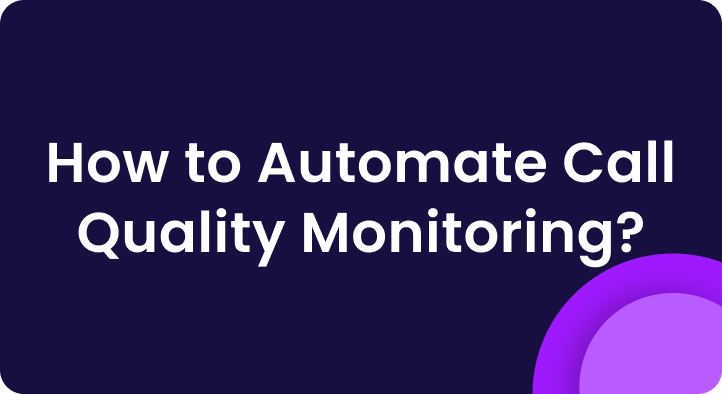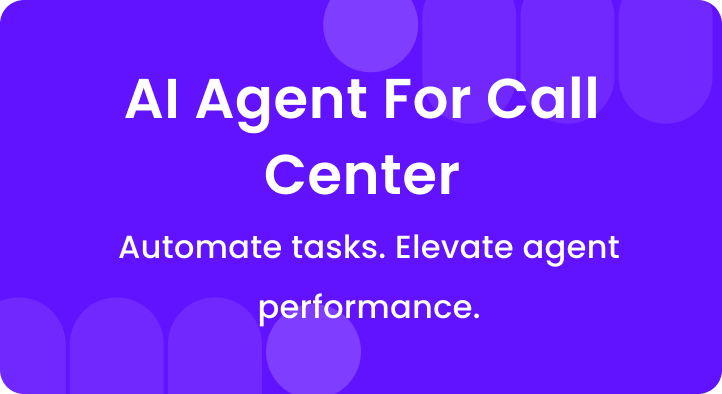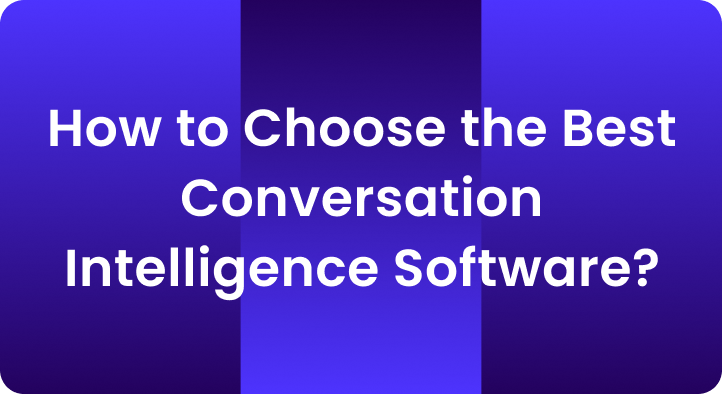How to Monitor Call Center Performance in 2026
Today’s contact centers are fast, digital, and under pressure to deliver stellar service.
Monitoring performance isn’t about spying or micromanaging; it’s about discovering what works, fixing what doesn’t, and lifting both agent morale and the customer experience.
In fact, even one negative experience can push 80% of customers toward a competitor.
By tracking calls and feedback, you catch issues early and prevent bad service from driving customers away.
At the same time, monitoring helps identify friction points that hurt agents’ productivity and happiness and happier, well-supported agents lead to happier, more loyal customers.
This guide breaks down what call center performance monitoring really means, a simple 5-step process to do it right, 10 proven best practices, and five quick ways to boost performance fast with or without a big budget.
Let’s dive in.
Upload Call & Get Insights
 DOWNLOAD DUMMY FILE
DOWNLOAD DUMMY FILE A. What is call center monitoring?
Call center monitoring means systematically tracking agent and team performance to improve service quality.
In practice, it involves evaluating customer interactions (calls, chats, etc.) and measuring key aspects like:
- Call quality,
- Customer satisfaction,
- Agent behavior,
- And compliance with scripts or policies.
Essentially, you collect and analyze data from contact center communications – employee efficiency metrics as well as factors affecting customer satisfaction (like clarity, empathy, or transfer rates).
Supervisors might listen to live or recorded calls and use software to score them.
Modern QA (Quality Assurance) tools even use AI to transcribe and analyze calls for sentiment and keywords.
What does monitoring cover?
Pretty much everything that defines a great call:
- Was the customer’s issue resolved?
- Did the agent follow the script and required compliance guidelines?
- Was the agent courteous and helpful?
- How did the customer feel about the interaction?
Monitoring can be done through various call monitoring software:
- Quality assurance software and dashboards that track metrics in real time,
- Call recordings you can play back later,
- Automated QA tools (like Enthu.AI) that use AI to score calls.
These tools help catch compliance issues or script deviations and ensure agents are following regulations and best practices.
Why does it matter?
Call monitoring is essential to increasing and maintaining high levels of customer satisfaction and efficiency.
It’s how you spot gaps in agent skills, identify customer pain points, and find call quality issues so you can address them.
With 63% of consumers saying companies need to get better at listening to feedback, measuring call quality through monitoring is vital to improving customer relationships.
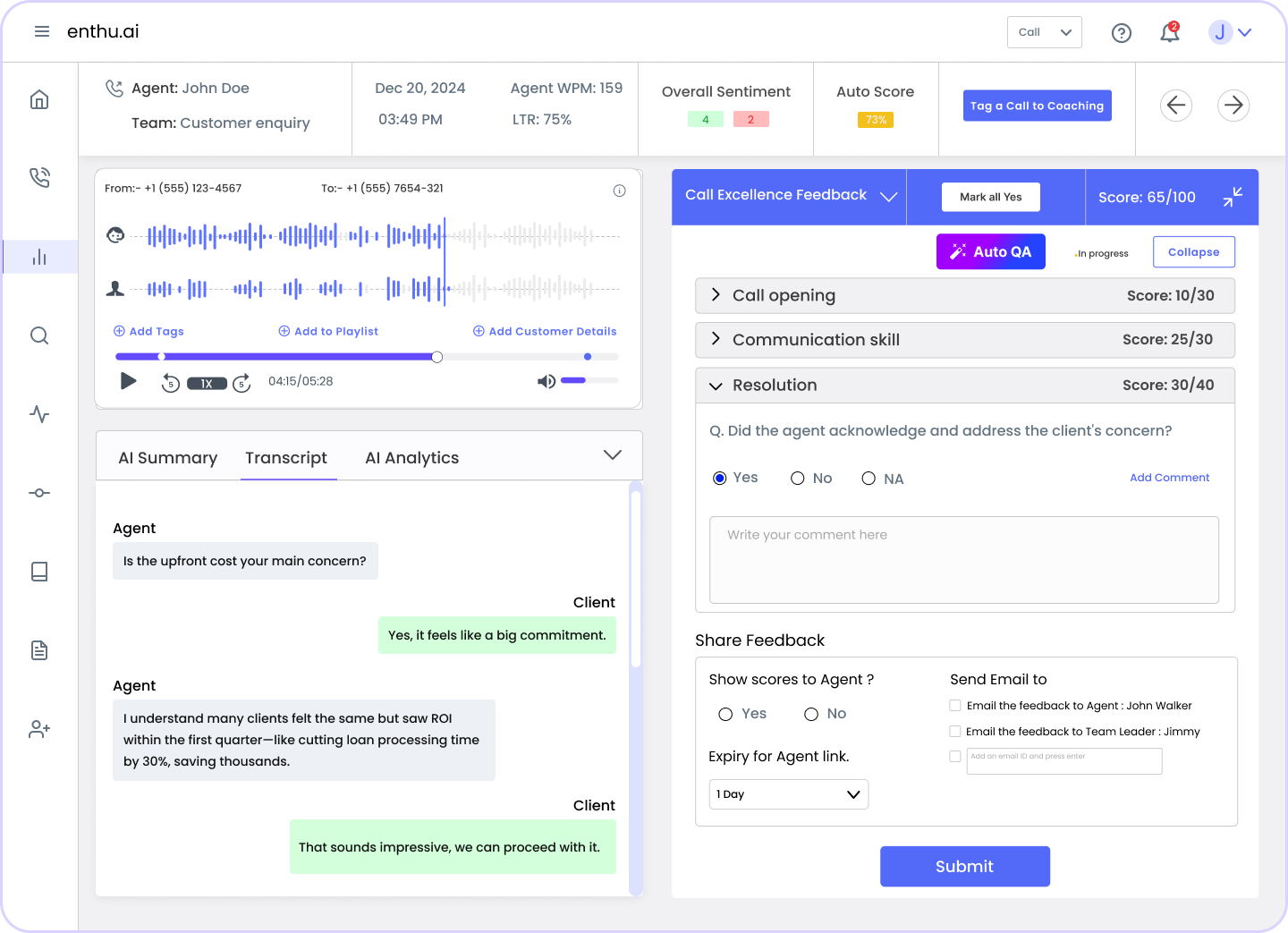
B. How call center performance is monitored: 5-step process
Monitoring call center performance might sound technical, but it boils down to a few clear steps.
Here’s a five-step process in simple terms:
1. Set clear KPIs
First, decide what success looks like.
Choose specific key performance indicators (KPIs) that align with your goals.
For example, if customer happiness is the goal, track CSAT scores; if efficiency is key, watch AHT or FCR.
Knowing exactly what you want to improve and how you’ll measure it ensures you’re focusing on the right numbers.
Common call center KPIs include:
- CSAT,
- FCR,
- AHT,
- Net Promoter Score (NPS),
- And Quality Assurance scores from call evaluations.
2. Use monitoring tools
Next, gather the data with the right tools.
This typically means:
- Call recording software,
- live dashboards,
- and QA platforms (like speech analytics or Auto-QA solutions to analyze interactions.)
For example, call recordings let you playback and evaluate any conversation, while speech analytics software can automatically flag calls where a customer was upset (negative sentiment) or where an agent missed a keyword.
Modern contact center platforms often include dashboards showing metrics in real time.
Therefore, you can spot issues (like a sudden spike in hold times) and resolve them fast.
Auto QA tools go a step further by using AI to listen to 100% of calls and score them for you.
They can flag if an agent forgot a compliance statement or if a customer sounded frustrated, so you don’t rely only on random call samples.
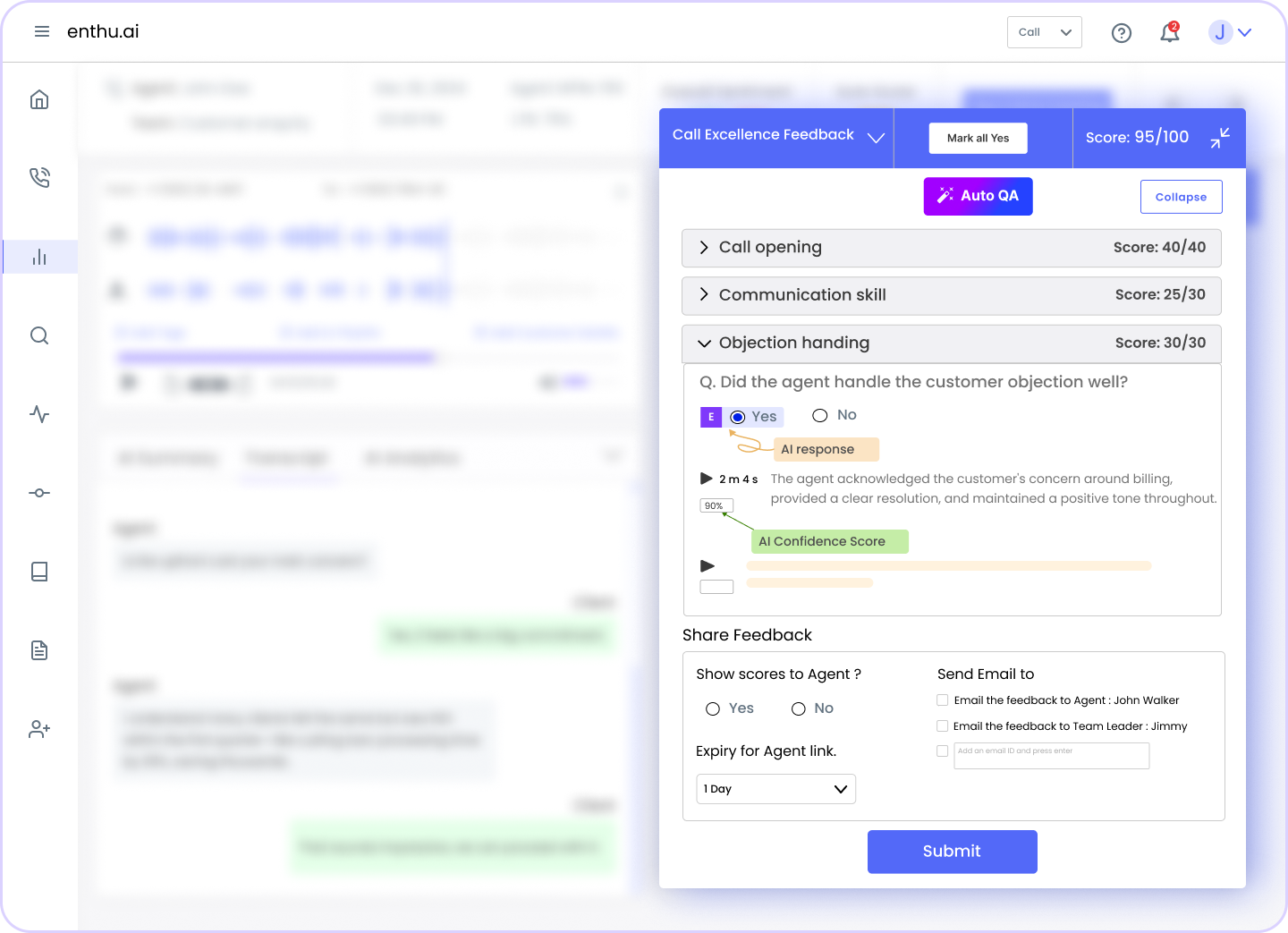
3. Review data regularly
Successful call centers review performance daily or weekly through scorecards, reports, and even transcripts of calls.
For instance, you might have a daily dashboard for each agent showing their yesterday’s stats and a weekly team report that highlights trends.
Regular review means you catch problems early.
If an agent’s QA scores have dropped this week, you notice it in the report and can find out why.
Consistent monitoring also involves listening to a sample of calls or reading chatbot transcripts to get qualitative insights behind the numbers.
The key is to make performance review a routine, whether in daily stand-ups, weekly ops meetings, or monthly one-on-ones.
4. Turn insights into action
This step is about taking the insights from your monitoring and using them to coach your team and tweak your operations.
For example, if monitoring shows that Agent A has great sales conversion on calls, you might have them share their technique with others (what’s working).
If it shows Agent B struggles with call openings, you can provide targeted coaching or a script refresher.
Maybe your average hold time spiked this month, you dig in and discover a workflow issue causing delays, then adjust your process.
Good monitoring programs feed directly into training sessions and process changes.
When agents see that the goal is to help them improve, they respond positively.
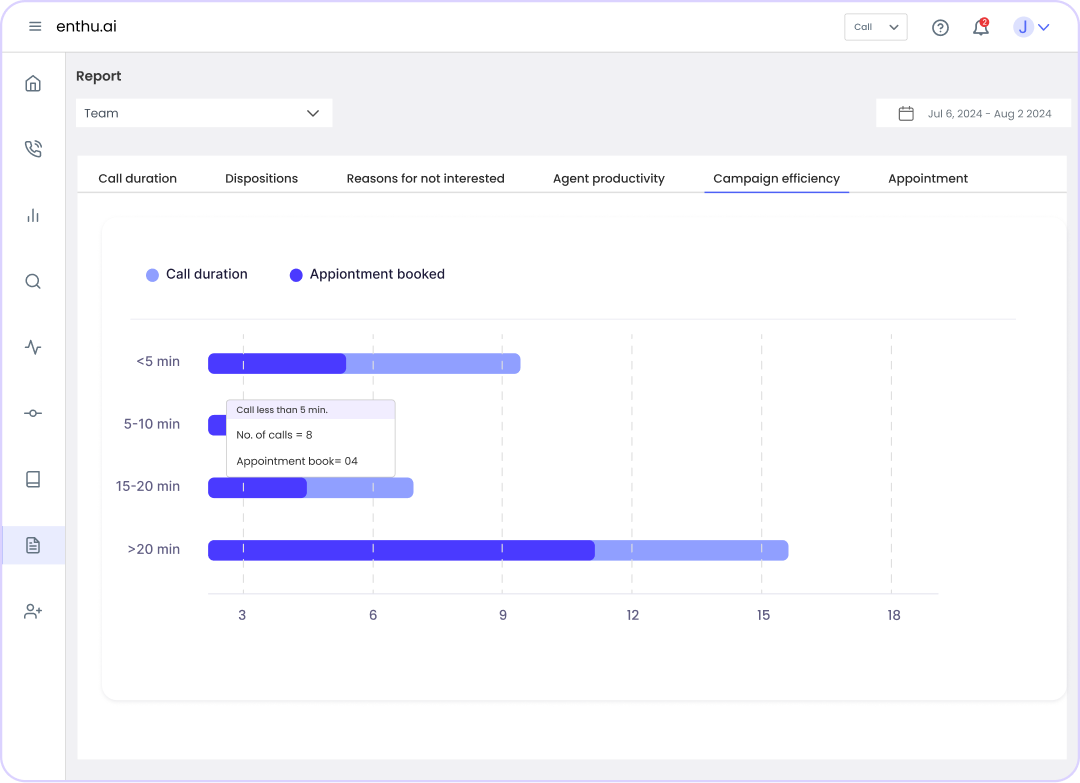
5. Continuously improve
Finally, performance monitoring is an ongoing cycle.
You’ll want to calibrate and refine over time.
Are your KPIs trending in the right direction? If not, why?
Perhaps you notice that despite good average handling time, first call resolution is low, which could signal the need for better training on problem-solving so customers don’t need to call back.
Or maybe customer feedback surveys indicate people love your support’s friendliness but want faster answers, so you might invest in a knowledge base or AI assistant to help agents retrieve info quicker.
Continuous improvement also involves updating your training materials and scorecards as needed.
By tracking progress and iterating, you ensure your call center keeps getting better.
C. 10 best practices to effectively monitor call center performance
Monitoring becomes truly powerful when you follow some best practices.
Here are 10 tips to help you get the most out of your call center performance monitoring:
1. Track metrics that matter, not vanity KPIs
Metrics guide your call center’s success but only if they’re meaningful.
Choose KPIs directly linked to customer happiness and efficiency.
Metrics like CSAT, FCR, and compliance are essential.
Avoid tracking too many metrics or irrelevant stats.
Always ask, “If this number changes, what action will I take?”
If you’re not clear, reconsider tracking that metric.
2. Use QA dashboards for fast issue resolution
Dashboards deliver real-time insights visually.
Quickly identify spikes in call volume or dips in resolution rates.
Drill down by individual agents or teams easily.
Customizable alerts help managers respond instantly.
A well-designed dashboard acts as your command center, allowing proactive issue management before problems escalate, maintaining excellent customer experiences.
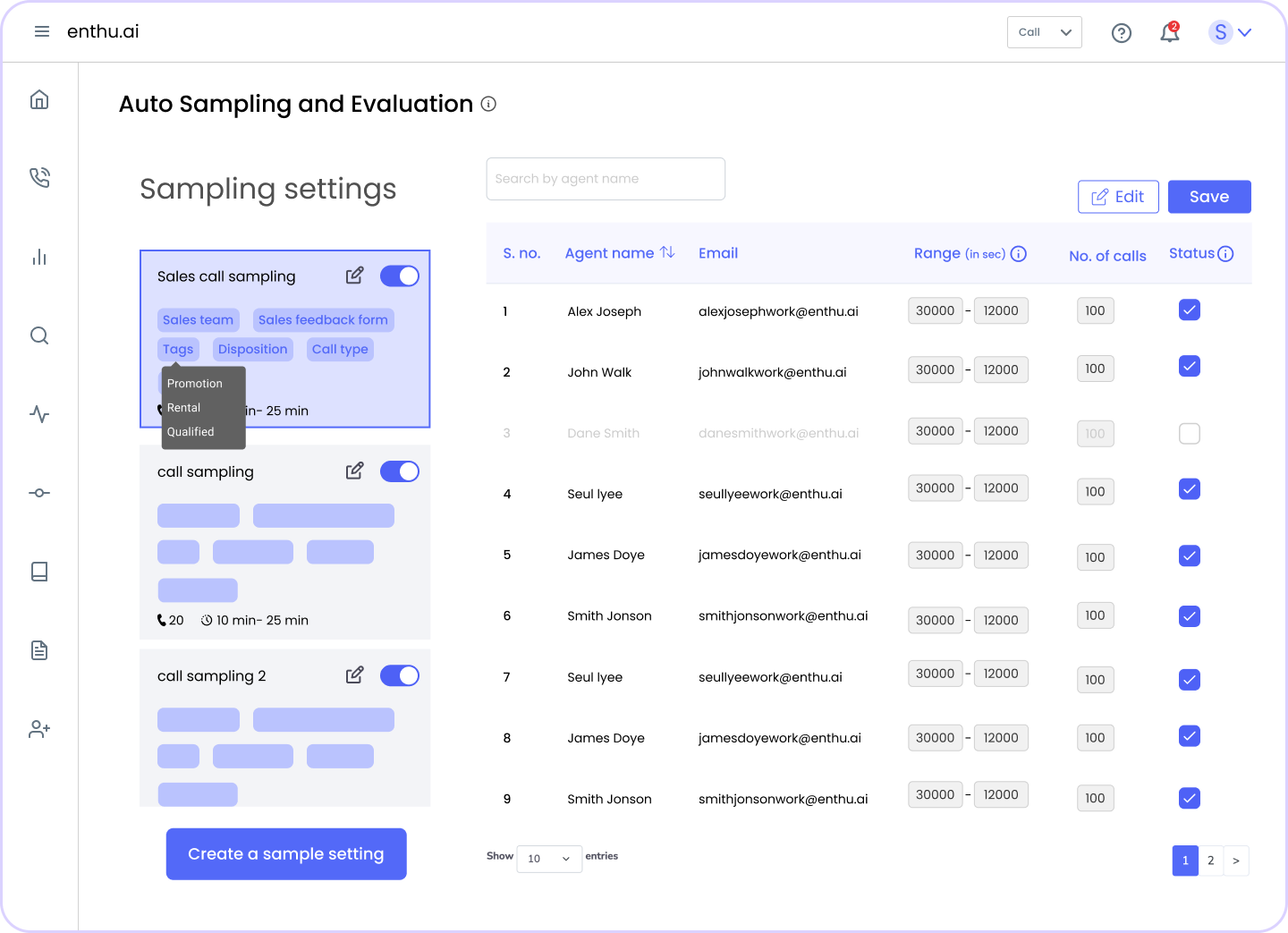
3. Leverage automated QA for scale
Automated QA covers every call far superior to manual sampling.
AI-driven systems analyze script adherence, compliance, and customer sentiment comprehensively.
It saves substantial time, letting managers focus on coaching rather than manual evaluations.
Automation delivers consistent insights, captures every issue, and dramatically enhances the depth of operational understanding, improving your team’s effectiveness.
4. Review call recordings and transcripts
Don’t rely solely on numerical data – customer voices matter.
Regularly listen to call recordings, especially unusual interactions.
Search transcripts for key phrases like “cancel” or “angry.”
Qualitative reviews reveal hidden problems such as agent fatigue or knowledge gaps.
Incorporating regular call reviews into your routine helps tailor effective coaching, boosting overall customer satisfaction.

5. Build clear agent scorecards
Clear, transparent agent scorecards set precise performance expectations.
Combine measurable metrics (handle time, script adherence) with soft skills (empathy, communication).
Clearly defined criteria encourage agents to focus effectively on key behaviors.
Regularly updating these scorecards with agent input ensures fairness and relevance.
Transparent scorecards simplify coaching, ensuring balanced performance improvements and higher agent engagement.
6. Use data in 1:1 coaching
Effective coaching relies heavily on performance data.
Discuss metrics openly in one-on-one meetings.
Celebrate strengths and identify areas needing improvement using actual call examples.
Ground feedback in real scenarios rather than vague comments.
Data-driven coaching promotes objective, constructive discussions, fostering a more receptive and motivated team
Ultimately, it enhances both individual and collective performance.
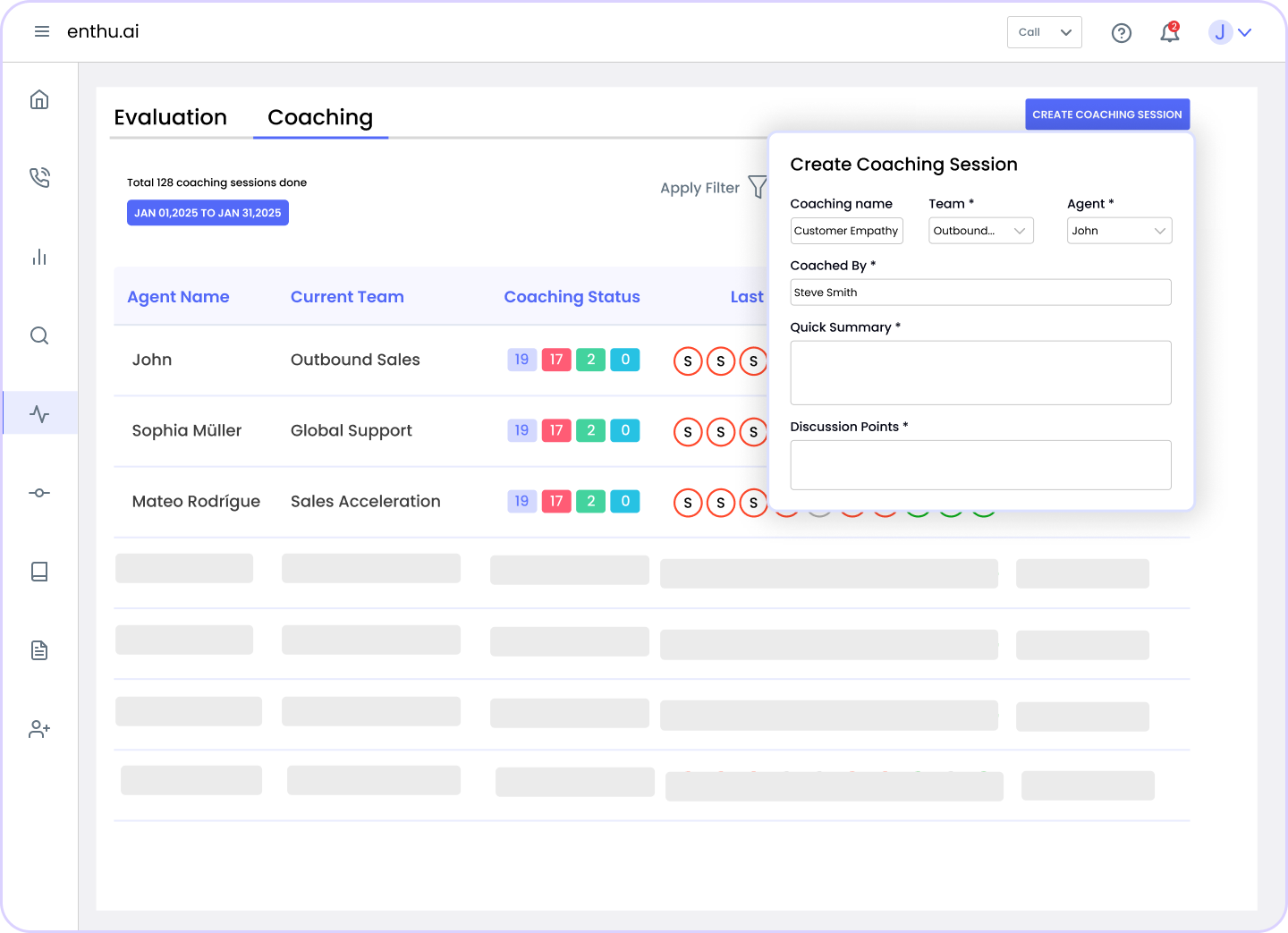
7. Compare team and agent rends
Analyze team and agent performance trends to understand broader patterns.
Quickly identify if issues are individual or systemic.
Benchmark against similar teams or previous periods to spot shifts.
Early detection allows timely interventions like targeted coaching.
Trend analysis reveals best practices among top performers, fostering a culture of shared learning and continual improvement within your team.
8. Collect and act on customer feedback
Customers offer valuable insights often overlooked by internal metrics.
Gather feedback through quick surveys after calls.
Regularly analyze customer comments alongside internal data.
Act promptly on common complaints or praise.
Sharing feedback trends with your team makes improvements tangible.
Closing feedback loops quickly improves customer loyalty, demonstrates genuine care, and provides clear directions for service enhancement.
9. Monitor compliance and scripting
Compliance and script adherence protect your business integrity.
Regularly monitor calls to ensure agents follow required disclosures and guidelines.
Leverage AI-powered analytics to automatically detect deviations.
Include compliance checks within scorecards to reinforce accountability.
Monitoring adherence safeguards your reputation, ensures consistency in customer interactions, and emphasizes the importance of following established protocols.
10. Hold regular performance reviews
Consistent reviews embed monitoring into your team’s culture.
Schedule weekly meetings focused on specific metrics.
Conduct monthly individual performance reviews.
Host quarterly deep-dive sessions to address broader trends.
Regular feedback prevents surprises and enables proactive improvement.
Structured performance discussions encourage transparency, timely recognition, and continual growth.
Also, it fosters a supportive environment committed to high standards and continuous learning.
Want to monitor your call center performance effectively?
Enthu lets you monitor 100% of your calls – no extra headcount needed. We even give 5 free evaluations to show you how.
D. Top 5 ways to improve call center performance
Monitoring is half the battle.
Now let’s end with a few quick, actionable tips to boost your call center’s performance:
1. Automate QA to save time
Free your supervisors from listening to endless call recordings by using AI-driven QA.
Automated monitoring tools can transcribe and score every call in minutes.
This not only ensures 100% call coverage but also drastically cuts down the time spent on manual reviews.
Managers can then focus on reviewing just the flagged calls and coaching agents, instead of sampling blindly.
The result?
Faster feedback for agents and more consistent quality.
In one case, an AI call monitoring system halved the QA review time while improving agent performance – a win-win for efficiency and quality.
2. Coach based on real data, not gut feeling
Use the insights from your monitoring to drive targeted coaching.
Instead of generic training sessions, leverage specific metrics and call examples for each agent.
For instance, if data shows an agent’s greeting scores are low, role-play better greetings.
If their empathy needs work, play a recording of a call and discuss how to add warmth.
Data-driven coaching makes feedback objective and actionable.
Agents are more receptive when you can say “On this call the customer got upset when we put her on hold – how could we handle that differently?”
The coaching sticks because it’s tied to real scenarios and outcomes, not just abstract advice.
3. Spot top and bottom performers early
Don’t wait for quarterly reports to identify who’s excelling and who’s struggling.
Continuously monitor and use dashboards to flag extremes.
High performers can be recognized and tapped as mentors or models for best practices.
Low performers can get help sooner – maybe an extra training or pairing with a buddy to improve.
For example, if an agent’s average customer satisfaction drops for two weeks straight, intervene in week three with support rather than waiting for a formal review.
Early identification also helps with staffing decisions; you might discover certain agents do better with certain call types and adjust assignments accordingly.
The sooner you act on performance signals, the easier it is to keep the whole team on track.
4. Use scorecards that balance metrics & soft skills
Make sure your evaluation criteria reward the behaviors you actually want.
A great way to improve performance is to adjust your scorecards and KPIs to emphasize both hard numbers and soft skills.
If agents know they are scored not just on speed but also on empathy, active listening, and resolution, they will prioritize quality service, not just quick service.
Regularly refine your scorecard weights based on what drives customer satisfaction in your center.
For example, if customers value a thorough answer more than a fast one, ensure your QA scoring gives credit for thoroughness.
A balanced scorecard guides agents toward well-rounded excellence – following procedure, showing empathy, and solving problems rather than “gaming” a single metric.
The improvement in customer sentiment will follow naturally.
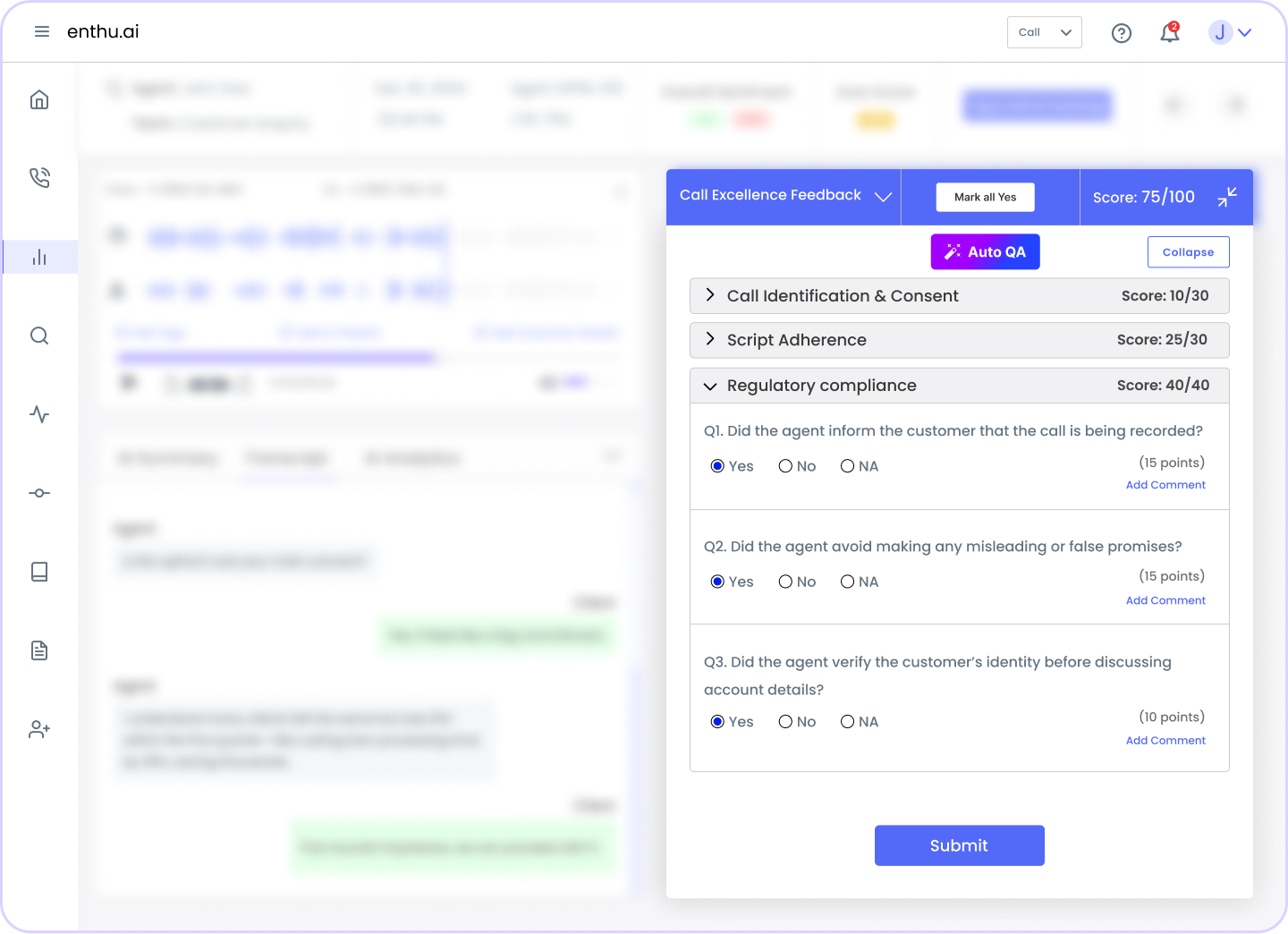
5. Celebrate wins to boost morale
Improving performance isn’t only about fixing mistakes; it’s also about positive reinforcement.
Make it a habit to celebrate successes, big or small.
Did an agent get a shout-out in a customer survey? Share it with the team.
Achieved a team record for FCR this month? Ring a bell (literally or figuratively) and congratulate everyone.
Recognizing achievements fuels motivation and morale.
It can be as simple as highlighting a “call of the week” that went really well, or having a fun reward for the team that hits their CSAT target.
When agents feel appreciated for good performance, they stay engaged and strive to repeat those wins.
High morale often translates into better service because happy agents create happy customers.
So, don’t monitor only to find problems; monitor to find and applaud the wins too.
Conclusion
In 2026, call center performance monitoring is the not-so-secret weapon behind great customer experiences and efficient operations.
By tracking meaningful metrics, leveraging modern QA tools, and acting on insights through coaching and process tweaks, you create a cycle of continuous improvement.
Whether you have a hefty budget for fancy software or you’re working with basic tools, the principles remain the same: set clear goals, measure what matters, listen to your customers, and support your agents.
Do this, and you’ll see tangible results – happier customers who feel heard and helped, and more confident agents who know you’ve got their back.
In a world where one bad call can lose a customer, a smart performance monitoring strategy ensures far more of your calls turn into wins for everyone.
FAQs
1. What are the three types of call monitoring?
The three main types are live monitoring (supervisors listen in real-time), recorded monitoring (reviewing past calls), and automated monitoring (using AI-driven tools to analyze calls systematically).
2. What is the 80/20 rule in a call center?
The 80/20 rule means answering 80% of calls within 20 seconds. It’s a widely-used benchmark to maintain efficient and responsive customer service.
3. What are the top 3 call center metrics?
The top three call center metrics are Customer Satisfaction (CSAT), First Call Resolution (FCR), and Average Handle Time (AHT). These directly reflect customer experience and operational efficiency.
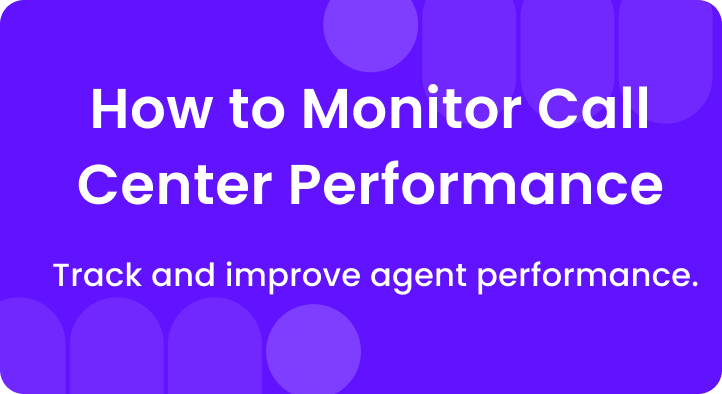
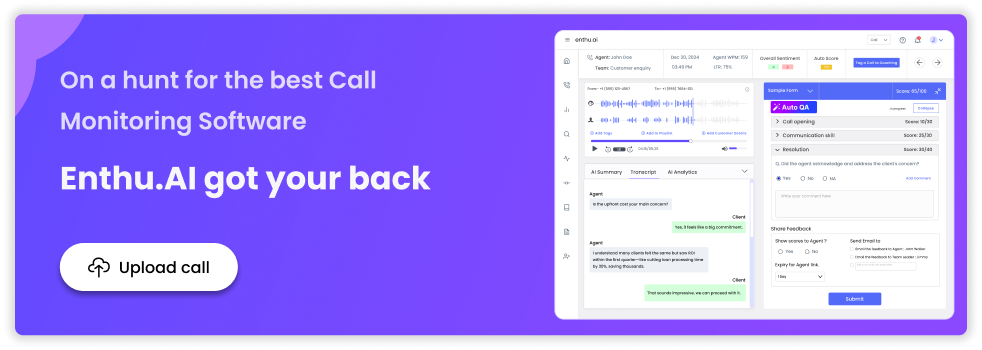

 On this page
On this page
